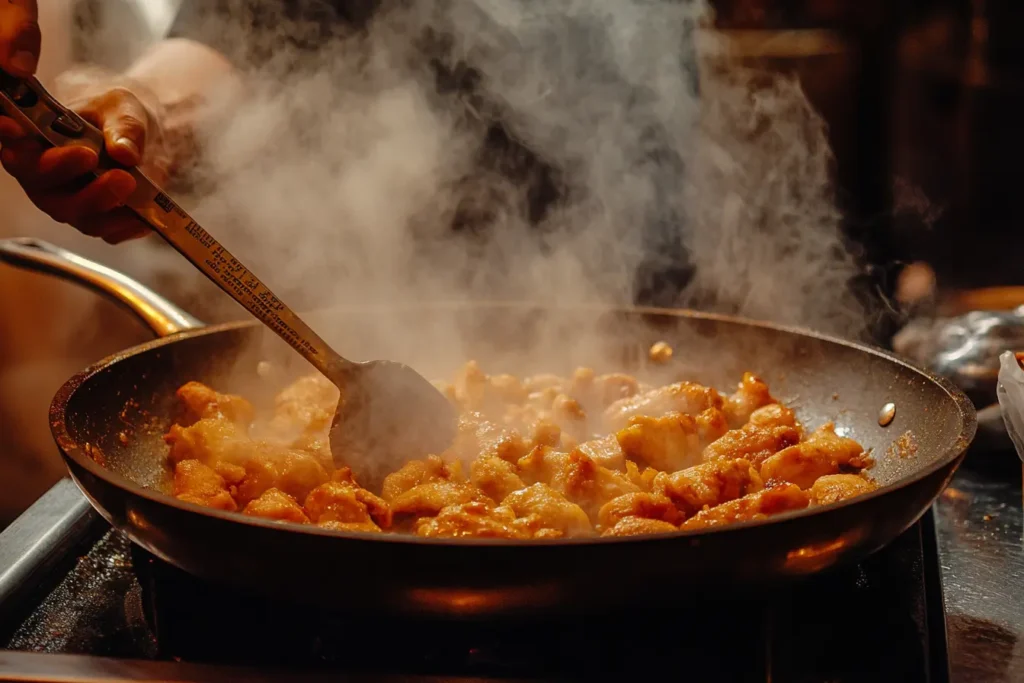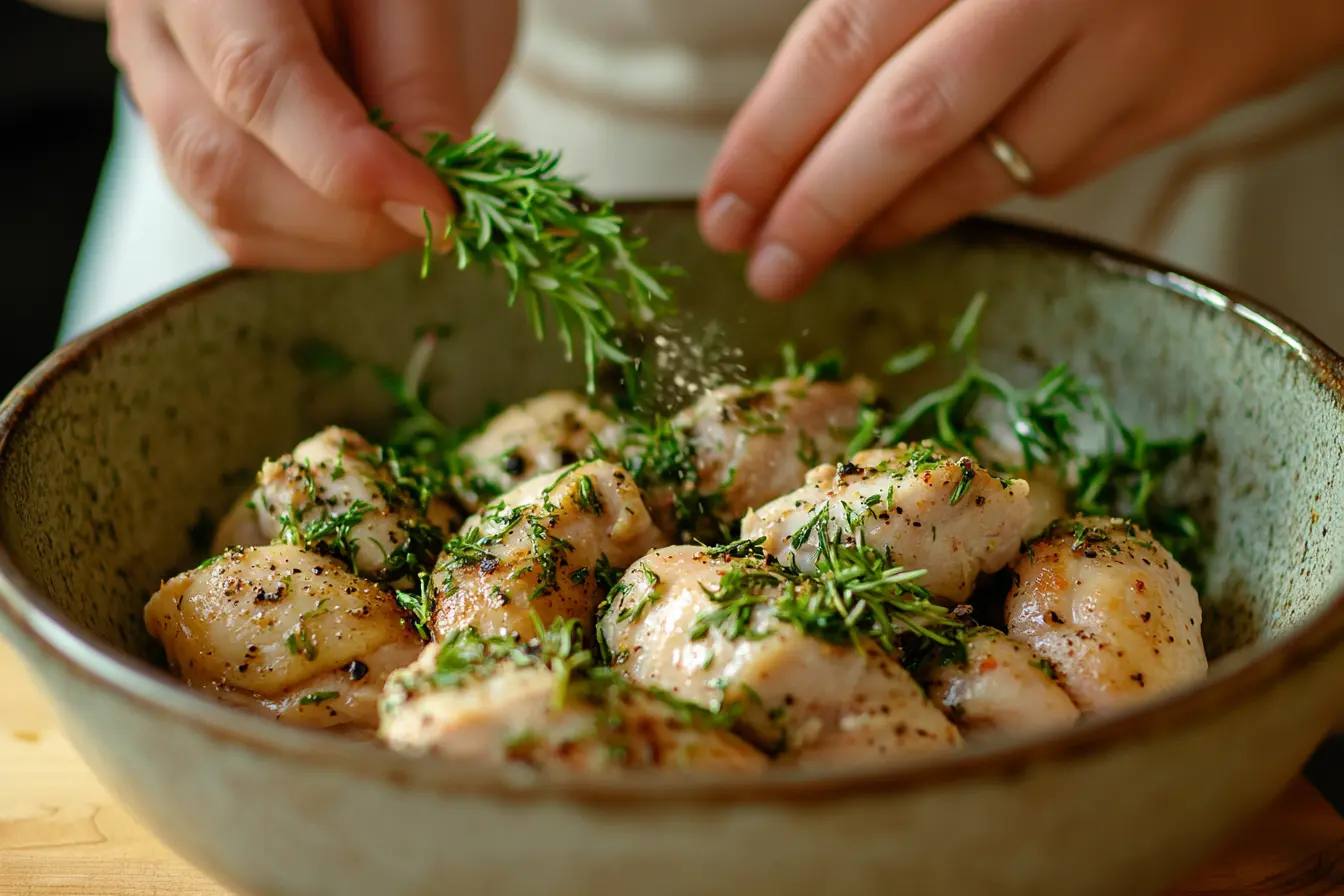Introduction
Learn how to prepare chicken like a professional chef! With the right tools, techniques, and understanding of culinary principles, you can elevate this humble protein into a restaurant-worthy dish.
Chicken is one of the most versatile proteins in the kitchen, yet it often falls short of its potential when improperly cooked. This guide will walk you through the techniques, tips, and secrets that professional chefs use to create juicy, flavorful chicken dishes. From mastering preparation methods to experimenting with advanced cooking techniques, this article will empower you to tackle chicken recipes with confidence and flair.
Now, let’s begin with the basics—understanding chicken cuts and the tools required to work like a pro.
Introduction to Cooking Chicken Like a Chef
Understanding Chicken Cuts
Cooking chicken like a chef starts with knowing your cuts. The anatomy of a chicken provides various parts, each with its unique cooking potential. Whether it’s the juicy thighs, versatile breasts, or flavor-packed wings, understanding how to choose the right cut is the cornerstone of creating exceptional dishes.
- Overview of Chicken Anatomy
A chicken is divided into primal cuts, including breasts, thighs, drumsticks, and wings. These cuts vary in texture, fat content, and cooking requirements. For instance:- Chicken breasts are lean and cook quickly but can dry out if overcooked.
- Thighs are forgiving due to their fat content, making them ideal for slow cooking.
- Drumsticks and wings shine in high-heat methods like grilling or frying.
- Selecting the Right Cut for Your Recipe
Matching the cut to your recipe ensures success. Use breasts for grilled or pan-fried dishes and thighs for stews or curries. For a rich, smoky flavor, grill drumsticks or wings.
Essential Tools and Equipment
To prepare chicken with the finesse of a chef, you’ll need the right tools. Investing in proper equipment enhances safety, precision, and cooking outcomes.
- Knives and Cutting Boards
A sharp chef’s knife is indispensable. Use it for slicing breasts, deboning thighs, and trimming fat. Pair it with a sturdy cutting board to maintain hygiene and prevent slipping. Wooden boards are excellent but sanitize them thoroughly. - Thermometers and Timers
Cooking chicken to the right internal temperature ensures safety and juiciness. A digital meat thermometer is a must-have tool. Chicken is safe to eat at 165°F (74°C) for breasts and 175°F (79°C) for thighs. Timers also help avoid overcooking. - Cookware Essentials
Choose heavy-bottomed pans for even heat distribution. Cast iron skillets, non-stick pans, and oven-safe dishes are versatile options. For roasting, use a rack to elevate the chicken and allow air circulation for crispy skin.
In the upcoming section, we’ll explore critical preparation techniques, including safe handling, marinating, and brining, to lay the groundwork for cooking chicken like a true culinary expert.
Preparation Techniques
Proper Chicken Handling and Safety
Handling chicken correctly is crucial for safety and maintaining its quality. The goal is to prevent contamination and ensure the chicken remains fresh for cooking.
- Safe Thawing Methods
Always thaw chicken in the refrigerator to keep it at a safe temperature. For faster thawing, submerge it in cold water, changing the water every 30 minutes. Avoid thawing at room temperature as it promotes bacterial growth. - Avoiding Cross-Contamination
Use separate cutting boards for chicken and other ingredients. Clean knives, surfaces, and hands thoroughly with hot, soapy water before and after handling raw chicken.

Marinating and Brining Methods
To infuse flavor and enhance texture, marinating and brining are indispensable techniques.
- Marinating Chicken
Marination adds depth of flavor and can tenderize the meat. Here’s a simple marinade recipe:
Ingredients for Marination:- 2 lbs chicken (any cut)
- 4 tablespoons olive oil
- Juice of 1 lemon
- 3 garlic cloves, minced
- 1 teaspoon paprika
- 1 teaspoon dried oregano
- ½ teaspoon salt
- ½ teaspoon black pepper
- Combine all ingredients in a large mixing bowl.
- Add chicken and coat thoroughly.
- Cover the bowl with plastic wrap or transfer the chicken into a resealable bag.
- Marinate in the refrigerator for at least 30 minutes, or up to 24 hours for best results.
- Brining Chicken
Brining is soaking chicken in a saltwater solution to lock in moisture. Here’s how to create a basic brine:
Ingredients for Brine:- 2 quarts water
- ¼ cup kosher salt
- ¼ cup sugar
- 2 bay leaves
- 1 tablespoon whole peppercorns
- Dissolve salt and sugar in warm water. Add bay leaves and peppercorns.
- Cool the brine completely before submerging the chicken.
- Cover and refrigerate for 2–6 hours.
- Rinse the chicken under cold water to remove excess salt and pat dry with paper towels.
Recipe: Pan-Seared Lemon Herb Chicken
This easy, flavorful recipe is perfect for a quick dinner or meal prep.
Ingredients:
- 4 chicken breasts
- 2 tablespoons olive oil
- 2 tablespoons unsalted butter
- 3 garlic cloves, minced
- Juice of 1 lemon
- 1 teaspoon dried thyme
- 1 teaspoon dried rosemary
- Salt and pepper to taste
Instructions:
- Prepare the Chicken: Season both sides of the chicken breasts with salt, pepper, thyme, and rosemary. Pat dry with paper towels for a better sear.
- Heat the Pan: Heat olive oil in a skillet over medium-high heat. Add butter and let it melt completely.
- Sear the Chicken: Place the chicken breasts in the pan. Cook for 5-7 minutes on one side without moving them, allowing a golden crust to form. Flip and cook the other side for another 5-7 minutes.
- Add Garlic and Lemon: Reduce the heat to medium-low. Add minced garlic and sauté for 1 minute until fragrant. Squeeze lemon juice over the chicken.
- Finish Cooking: Cover the pan and let the chicken cook for an additional 2-3 minutes until the internal temperature reaches 165°F (74°C).
- Rest and Serve: Remove the chicken from the pan, let it rest for 5 minutes, and serve with your favorite sides.
Nutritional Content (per 100g)
Here’s the nutritional breakdown for the pan-seared lemon herb chicken recipe.
| Nutrient | Amount (per 100g) |
|---|---|
| Calories | 165 kcal |
| Protein | 31 g |
| Fat | 3.6 g |
| Carbohydrates | 0 g |
| Cholesterol | 85 mg |
| Sodium | 74 mg |
In the following segment, we’ll delve into the art of cooking chicken using various methods, such as roasting, frying, and grilling, to achieve culinary perfection.
Cooking Methods
Cooking chicken like a chef requires understanding and mastering different methods. Whether you prefer a crispy sear, tender roasted pieces, or smoky grilled flavors, these techniques will ensure delicious results every time.
Pan-Frying and Sautéing
This method is perfect for quick, flavorful chicken with a crispy exterior.
Steps for Pan-Frying Chicken:
- Prepare the Pan: Heat 2 tablespoons of oil in a heavy-bottomed skillet over medium-high heat until shimmering.
- Season the Chicken: Pat chicken dry and season generously with salt, pepper, and your preferred spices.
- Cook: Place chicken in the pan. Cook undisturbed for 5-6 minutes to develop a golden-brown crust. Flip and cook the other side for another 5 minutes.
- Rest: Remove the chicken and let it rest for 5 minutes before serving to lock in juices.
Tips for Sautéing:
- Slice chicken into thinner pieces for even cooking.
- Use butter for added flavor but mix it with oil to prevent burning.
Roasting and Baking
Roasting brings out a chicken’s natural flavor and provides a crispy, caramelized skin.
Steps for Roasting Chicken:
- Preheat and Prep: Preheat your oven to 425°F (220°C). Rub chicken with olive oil and season with salt, pepper, garlic powder, and herbs like thyme or rosemary.
- Elevate: Place the chicken on a roasting rack or bed of vegetables to allow airflow beneath.
- Cook: Roast a whole chicken for about 20 minutes per pound, or until the internal temperature reaches 165°F (74°C).
- Rest: Let the chicken rest for 10-15 minutes before carving to allow the juices to redistribute.
Grilling Techniques
Grilling imparts a smoky flavor and is ideal for summer barbecues.
Steps for Grilling Chicken:
- Prepare the Grill: Preheat the grill to medium-high heat. Oil the grates to prevent sticking.
- Season or Marinate: Season chicken generously or use your favorite marinade. For bone-in pieces, marinate for at least 4 hours.
- Cook with Care: Place chicken on the grill. For boneless breasts, cook for 6-8 minutes per side. Bone-in pieces may take 10-12 minutes per side. Use indirect heat to avoid burning.
- Check Temperature: Always ensure the chicken reaches a safe internal temperature of 165°F (74°C).

Poaching and Simmering
For a moist, tender chicken, poaching is a gentle and effective cooking method.
Steps for Poaching Chicken:
- Prepare the Liquid: In a pot, combine water, salt, bay leaves, peppercorns, and aromatics like garlic or onions.
- Add Chicken: Place chicken in the liquid. Bring to a gentle simmer (not a boil).
- Cook: Simmer for 15-20 minutes for breasts or until the internal temperature reaches 165°F (74°C).
- Cool and Shred: Let the chicken cool slightly, then shred it for salads, soups, or sandwiches.
Nutritional Content (per 100g)
Here’s how these cooking methods affect the nutritional content of chicken:
| Cooking Method | Calories | Protein | Fat | Sodium |
|---|---|---|---|---|
| Pan-Frying | 200 kcal | 28 g | 7 g | 65 mg |
| Roasting | 190 kcal | 30 g | 6 g | 60 mg |
| Grilling | 170 kcal | 31 g | 4 g | 70 mg |
| Poaching | 150 kcal | 32 g | 1 g | 50 mg |
In the ensuing segment, we’ll delve into advanced cooking techniques, including sous vide and trussing, for creating chef-quality chicken dishes.
Advanced Techniques
To truly cook chicken like a chefs, mastering advanced techniques is a game-changer. These methods not only enhance flavor and texture but also introduce precision and finesse to your cooking. Let’s explore sous vide cooking, stuffing, and trussing, which elevate your chicken dishes to professional standards.
Sous Vide Cooking
Sous vide, or cooking “under vacuum,” involves sealing chicken in a vacuum-sealed bag and cooking it in a water bath at a precise, controlled temperature. This method ensures tender, evenly cooked chicken every time.
Benefits of Sous Vide:
- Guarantees perfectly cooked chicken with no risk of overcooking.
- Retains moisture and enhances flavor by cooking in its juices.
Steps for Sous Vide Chicken:
- Prepare the Chicken: Season chicken breasts with salt, pepper, and optional herbs like thyme or rosemary. Add a drizzle of olive oil or a pat of butter.
- Seal the Bag: Place the chicken in a vacuum-sealed bag or a resealable bag using the water displacement method to remove air.
- Set the Temperature: Heat a sous vide water bath to 145°F (63°C) for tender, juicy chicken.
- Cook: Submerge the sealed bag in the water bath and cook for 1–1.5 hours.
- Sear for Flavor (Optional): After cooking, quickly sear the chicken in a hot skillet for 1 minute on each side to add a golden crust.
- Serve: Slice and serve the chicken with your favorite sauces or sides.
Stuffing and Trussing
Stuffing adds flavor from the inside out. Common fillings include herbs, garlic, breadcrumbs, and vegetables.
Steps for Stuffing a Whole Chicken:
- Prepare a stuffing mixture of sautéed onions, garlic, breadcrumbs, and your choice of fresh herbs.
- Gently stuff the mixture into the chicken cavity, being careful not to overfill.
- Secure the opening with a skewer or by folding the skin over.
Trussing a Chicken:
Trussing ensures even cooking by keeping the chicken compact and retaining juices.
Steps for Trussing:
- Place the chicken breast-side up. Slide kitchen twine under the tail and bring it up to the legs.
- Cross the legs and tie them together securely.
- Wrap the twine around the wings and tie it behind the back to keep everything in place.
Nutritional Content (per 100g)
Here’s the nutritional breakdown for sous vide and stuffed chicken methods:
| Cooking Method | Calories | Protein | Fat | Sodium |
|---|---|---|---|---|
| Sous Vide | 140 kcal | 30 g | 1.5 g | 50 mg |
| Stuffed and Trussed | 210 kcal | 26 g | 9 g | 75 mg |
Frequently Asked Questions (FAQs)
How to make chicken pieces tender?
Tenderizing chicken can be achieved through various methods:
- Marinating: Use acidic ingredients like lemon juice, yogurt, or vinegar in your marinade to break down proteins.
- Pounding: Place the chicken pieces between two sheets of plastic wrap and gently pound them with a meat mallet to even out thickness and break up tough fibers.
- Brining: Soak chicken in a saltwater solution for 2-6 hours to lock in moisture and soften the meat.
- Cooking Low and Slow: Use slow cooking methods like poaching or braising to gradually tenderize the meat.
How to mash raw chicken?
To mash raw chicken, you can:
- Use a Food Processor: Cut the chicken into small chunks and pulse it in a food processor until it reaches the desired consistency.
- Chop Finely: Manually chop the chicken into very fine pieces using a sharp knife.
- Blend: If no food processor is available, use a blender in small batches, adding a bit of liquid like broth if needed.
This method is commonly used for making chicken patties or filling for dumplings.
Does oat flour rise with yeast?
Oat flour does not contain gluten, which is essential for creating the elastic structure needed for yeast-based rising. While it can absorb liquid and contribute to the dough’s density, oat flour works best when combined with other gluten-containing flours like wheat. Alternatively, use baking powder or baking soda as leavening agents if you’re making gluten-free recipes.
Can I use oat flour alone for baking?
Yes, but the texture may be denser and less elastic compared to wheat-based recipes. For better results, mix oat flour with a gluten-free flour blend or use recipes specifically designed for oat flour.
What is the best way to cook chicken for meal prep?
The best way is to bake, roast, or poach chicken. These methods retain moisture and provide a neutral flavor, making the chicken versatile for multiple recipes. Season lightly or marinate to add flavor, then portion the cooked chicken for salads, wraps, or grain bowls.
How do I know when chicken is fully cooked?
- 165°F (74°C) for breasts.
- 175°F (79°C) for thighs and drumsticks.
Visually, the juices should run clear, and there should be no pink in the thickest part of the chicken.

